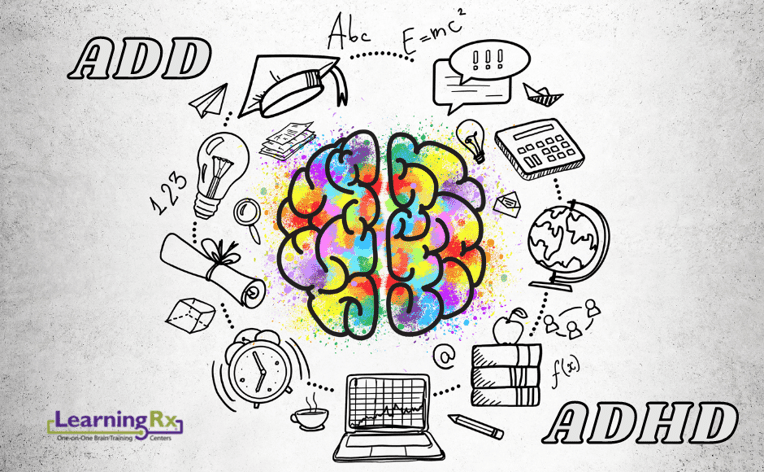What Is the Difference Between ADD and ADHD?
Attention deficit hyperactivity disorder (ADHD) is a neurological condition that results in a variety of symptoms involving attention, impulse control, and hyperactivity. The group of symptoms and behaviors caused by ADHD have been recognized as far back as 1902, though the name for the disorder has changed over time.
In their most recent national survey of children’s health (2016), the CDC estimated that 9.4% of children and teens in the United States have been diagnosed with ADHD.
As for the difference between ADD and ADHD: according to the DSM-5, both are considered to be subtypes of the same condition, each with slightly different symptoms.
The Three Types of ADHD
In fact, there are three subtypes of ADHD:
- Inattentive ADHD (also referred to as ADD): Inattentive symptoms only
- Hyperactive-Impulsive ADHD: Hyperactive/impulsive symptoms only
- Combined ADHD: Both inattentive and hyperactive/impulsive symptoms
The difference between ADD and ADHD shows up in the varying symptoms of each subtype. One person’s ADHD symptoms can be drastically different from another’s, depending on which of the three disorders they have.
In general, what are typically thought of as ADD/ADHD symptoms — hyperactivity and impulsivity, a child who can’t sit still, etc. — signify either of the latter two subtypes, while ADD (or inattentive ADHD) symptoms revolve around problems with attention.
Combined ADHD, with symptoms of both hyperactivity and inattention, is the most common of the three types.
To diagnose a child with any one of the ADHD types,
- Symptoms must appear before the child is seven years old;
- Symptoms must be present in more than one setting (at home, at school, in social situations, etc); and
- Symptoms must have a clearly negative effect on the child’s ability to function normally in these settings
Symptoms of Inattentive ADHD (ADD)
Contrary to the typical perception of ADHD, people with this subtype are not hyper or impulsive. Rather, they tend to struggle with lack of focus, forgetfulness, disorganization, and difficulty listening.
According to the DSM-5, for children to be diagnosed with inattentive ADHD, six or more of the following symptoms must be present often and clearly impacting school or work:
- Fails to pay close attention to details or makes careless mistakes in schoolwork, at work, or in other activities
- Has trouble keeping their attention focused on tasks or play activities
- Does not seem to be listening when spoken to directly
- Does not follow through on instructions and fails to finish schoolwork, chores, or duties in the workplace — they lose focus or become side-tracked
- Has trouble organizing tasks and activities
- Avoids, dislikes, or is reluctant to do tasks that require sustained mental effort over a long period of time (such as schoolwork or homework)
- Loses things necessary for their tasks and activities, such as school materials, paperwork, wallet, keys, eyeglasses, or cell phone
- Is easily distracted
- Is forgetful in daily activities
For adults 17 years and older to be diagnosed, only five of these symptoms need to be present. In addition, for adults and children alike, symptoms of inattention must have been present for at least six months and be inappropriate for the person’s developmental level.
Symptoms of Hyperactive-Impulsive ADHD
This type of ADHD is the one many of us imagine when we think of ADHD: the hyper child who bounces off the walls, interrupts the teacher, and disrupts the class. But these are not the only symptoms of hyperactive-impulsive ADHD — in fact, many children who are diagnosed with this subtype don’t fit that description at all.
To be diagnosed with hyperactive-impulsive ADHD, a child must often exhibit six or more of the following symptoms:
- Fidgets with or taps hands or feet or squirms in their seat
- Leaves their seat in situations when they are expected to remain seated
- Runs around or climbs in situations where such behavior is not appropriate (adolescents or adults may simply feel restless)
- Is unable to play or take part in leisure activities quietly
- Is often “on the go,” or acts as if they are “driven by a motor”
- Talks excessively
- Blurts out an answer before a question has been completed
- Has trouble waiting their turn
- Interrupts or intrudes on others (i.e., butts into conversations or games)
Adults 17 years and older must exhibit five or more of these symptoms to be diagnosed with this type of ADHD. Additionally, for both adults and children, these symptoms must have been present for at least six months to an extent that is disruptive and inappropriate for the person’s developmental level.
Combined Type ADHD
Combined type ADHD, as the name suggests, includes symptoms of both inattentive ADHD and hyperactive-impulsive ADHD.
To be diagnosed with combined type ADHD, a child must exhibit six or more symptoms of inattention and six or more symptoms of hyperactivity and impulsivity (adults must exhibit five or more symptoms of each).
Brain Training With LearningRx Strengthens Attention Skills
Whether you or your child are diagnosed with inattentive ADHD (ADD), hyperactive-impulsive ADHD, or combined type ADHD, there is hope for improvement.
Brain training, a form of cognitive training, can strengthen the cognitive skills our brain uses every day to think, learn, and perform — including attention skills. Improved attention skills can help people with ADHD improve their performance at school or work.
While LearningRx does not diagnose or treat any of the types of ADHD, our brain training program has helped people with various diagnoses — including ADHD — strengthen their cognitive skills.
If you think you or your child would benefit from brain training, reach out to us today to get started.







